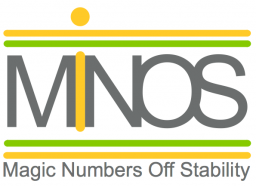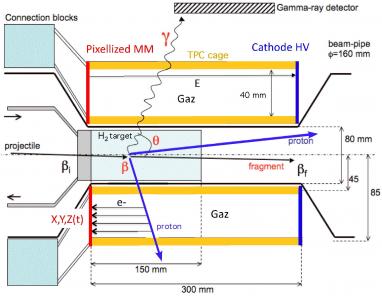Scientific Issues and Project Framework
The MINOS project aims at performing the spectroscopy of very exotic nuclei produced by fragmentation at the radioactive ion beam facilities such as RIKEN or GSI / FAIR. The structure of the targeted atomic nuclei should allow us to bring strong constraints on the nuclear interaction acting between nucleons in the nucleus. It should also provide us with essential information as to our understanding of the origin of nuclei and of the matter abundance in the universe.
Several groups around the world are studying the structure of exotic nuclei. The asset of the MINOS project is the development of a new instrument that, coupled with existing detectors, will provide increased sensitivity (up to several hundred gain) over current methods.
The basic principle of MINOS is to unlock a technical problem, offering the possibility of using very thick targets to make studies by gamma spectroscopy and direct secondary reactions, while maintaining a good energy resolution of the measured gamma spectra.
On 20 October 2010, the European Union awarded an ERC grant (FP7 / ERC Grant agreement n ° 258567 of the "SP2-ideas" program) to Alexandre Obertelli (PI, DPhN) to make a financial contribution to the MINOS project over 5 years.
The instrument and its technical issues
The project proposes to implement a new experimental method: the use of a liquid hydrogen target coupled to a micromegas MPGD vertex detector and an AGATA or DALI2 germanium detector.
Instrument:
Target of liquid hydrogen coupled to a TPC read by Bulk-Micromegas to reconstruct the trajectories of the protons produced in the target and to locate the vertex of the nucleus-target interaction with an accuracy of 2-3 mm.
Specifities:
- Bulk-Micromegas + read-out electronics GET (Generic Electronics for TPC).
- Compact geometry coupled to a thick liquid H2 target (~150 mm).
Technical issues:
- cylindric TPC bulk-micromegas of high spatial resolution (pads of ~4 mm2) without magnetic field, of high dynamic range, allowing a particle flux of ~10 kHz of the reaction products coming from the interactions of the exotic nuclei in the target.
- Dense read-out electronics (4096 à 8192 voies sur ~150 cm2) based upon the ASIC AGET (GET - General Electronics for TPCs is a program funded by the ANR and led by IRFU).
- Liquid hydrogen target, 150 mm-thick, at 20K.
Collaboration and IRFU responsibilities
Collaborations: RIKEN, PRESPEC ( GSI/FAIR), AGATA
Responsibilities: IRFU (complete instrument and physics program).
Deliverables (FP7/ERC): Complete instrument complet validated in in-beam tests before the end of 2013 and first physics experiments at RIKEN before the end of 2015.
Calendar and highlights
The MINOS Project is supported by the ERC as part of the FP7 for 5 years from 1st November 2010. The R & D phase, detailed design and realization will be validated by an in-beam test of the instrument mid 2013, to allow its exploitation in the framework of at least one experiment of spectroscopy of exotic nuclei at the RIKEN institute (using the gamma detector DALI2) before the end of the project in November 2015.
• Structure of nuclear matter › Atomic nucleus
• Accelerators, Cryogenics and Magnetism Division (DACM) • Institute of Research into the Fundamental Laws of the Universe • Le Département d'Électronique des Détecteurs et d'Informatique pour la Physique (DEDIP) • The Electronics, Detectors and Computing Division • The Nuclear Physics Division • The Systems Engineering Division
• Laboratoire des systèmes de détection (LASYD) • Système temps réel, électronique d'acquisition et microélectronique (STREAM) • LENA group - Structure of the Atomic Nuclei



